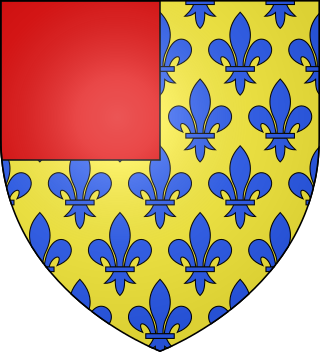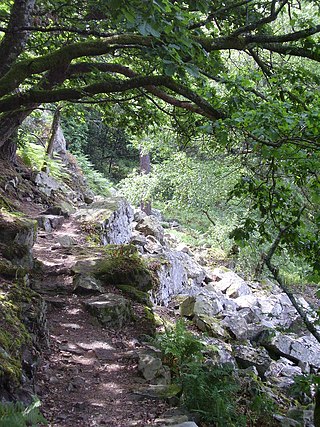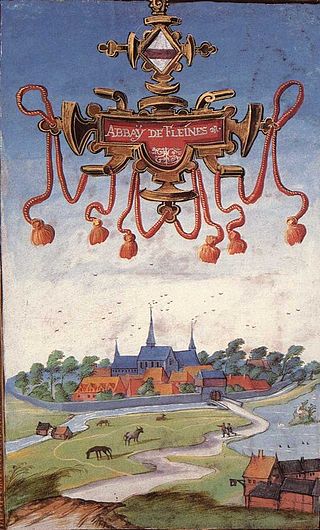
Guy of Thouars was Duke of Brittany from 1199 to 1201 as the third husband of Constance, Duchess of Brittany. They married in Angers, County of Anjou, between August and October 1199 after her son Arthur entered Angers to be recognized as count of the three countships of Anjou, Maine and Touraine. He was an Occitan noble, a member of the House of Thouars.
Adam of Perseigne was a French Cistercian, abbot of Perseigne Abbey in the Diocese of Le Mans.

Neufchâtel-en-Saosnois is a commune in the Sarthe department in the region of Pays de la Loire in north-western France.
Gerald of Sales was a French monastic reformer from Salles, Lot-et-Garonne near Bergerac, Dordogne in the south-west of France. His feast day is on April 20.
Thomas of Perseigne, also known as Thomas of Cîteaux, Thomas Cisterciensis, Thomas the Cistercian, Thomas of Vancelles, was a Cistercian monk of Perseigne Abbey, in what is now Sarthe, France. He is known for one major work, a commentary on the Song of Songs.

Helie of Burgundy was the daughter of Odo I, Duke of Burgundy and Sibylla of Burgundy, Duchess of Burgundy.

Normandie-Maine Regional Natural Park is a protected area of forest and bocage located in the French regions of Normandy and Pays de la Loire.

L'Épau Abbey is a former Cistercian abbey founded by the English queen Berengaria of Navarre in 1229. It is located on the outskirts of the city of Le Mans, on the left bank of the Huisne, adjoining the town of Yvré-l'Évêque. The abbey was suppressed in the French Revolution. The surviving buildings came close to destruction on several occasions, but their preservation was finally assured in 1958 by the General Council of the Sarthe department.

Val-Saint-Lambert Abbey was a Cistercian abbey in the Prince-Bishopric of Liège. It is situated in the Walloon municipality of Seraing, on the right bank of the Meuse, in Belgium, about 13 km (8.1 mi) south-west of Liège. Founded in 1202, the abbey's monks were expelled during the French Revolution. In the 19th century, the building ruins were converted into the Val Saint Lambert crystal factory. The structure is considered to be an important example of Cistercian architecture.
Belleau Abbey, later Belleau Priory, was a Cistercian monastery in Villeneuve-la-Lionne, Marne, France, about 15 kilometres south-west of Montmirail.

Fontenelle Abbey was a Cistercian nunnery in Maing, Nord, France, extant from 1212 to 1793.
The canton of Mamers is an administrative division of the Sarthe department, northwestern France. Its borders were modified at the French canton reorganisation which came into effect in March 2015. Its seat is in Mamers.
Tugal Caris, also spelled Carris or Cariste, was a 17th-century French ecclesiastical sculptor and ecclesiastical architect who worked in Nantes and Rennes. He was one of the creators of elaborate altarpieces in a new style invented by sculptors from Laval.

Flines Abbey was a Cistercian nunnery in Flines-lez-Raches near Douai, in the Nord department of France. It was founded in about 1234 by Countess Margaret of Flanders, and served as the burial place not only of Margaret in 1278 but of Margaret's husband William II of Dampierre and their son Guy, Count of Flanders (1304), as well as of Guy's wives Matilda of Béthune (1263) and Isabelle of Luxembourg (1298).

The Abbaye de la Fille-Dieu is a Cistercian monastery located near the town of Romont in the Swiss Canton of Fribourg. Founded as a Benedictine priory in 1268, and continuously occupied by a community of nuns since its establishment, the alpine abbey is a Swiss heritage site of national significance. Heavily altered through its history, Fille-Dieu was restructured by economic turmoil, fire, additions and unsympathetic alterations. In 1906 the abbey became affiliated with the Trappists, and between 1990 and 1996 an internationally notable restoration was undertaken, modernising the monastic buildings, restoring the abbey church to its original volume, and preserving its rediscovered medieval murals, with the only contemporary element a suite of stained glass windows commissioned from the British artist Brian Clarke. Further restoration of the abbey continues today.

Les Écharlis Abbey is a former Cistercian monastery in Villefranche, Yonne, France. It was founded in the 12th century by a secular priest with two companions who wanted to live a monastic life. Soon afterward, the monastery joined the Cistercian order as a dependency of Fontenay Abbey.
Jean-François Leroux-Dhuys was a French writer and historian.
Helinand of Perseigne was a Cistercian monk and writer. He was the procurator of the Perseigne Abbey during the abbacy of Adam. He wrote a commentary on the Book of Revelation, mentioned by John of Wales around 1280. It is now lost. Some preserved glosses on the Book of Exodus are also attributed to him.

Beaugerais Abbey is a former Cistercian abbey, located in what is now the commune of Loché-sur-Indrois, in the Indre-et-Loire département of France.











